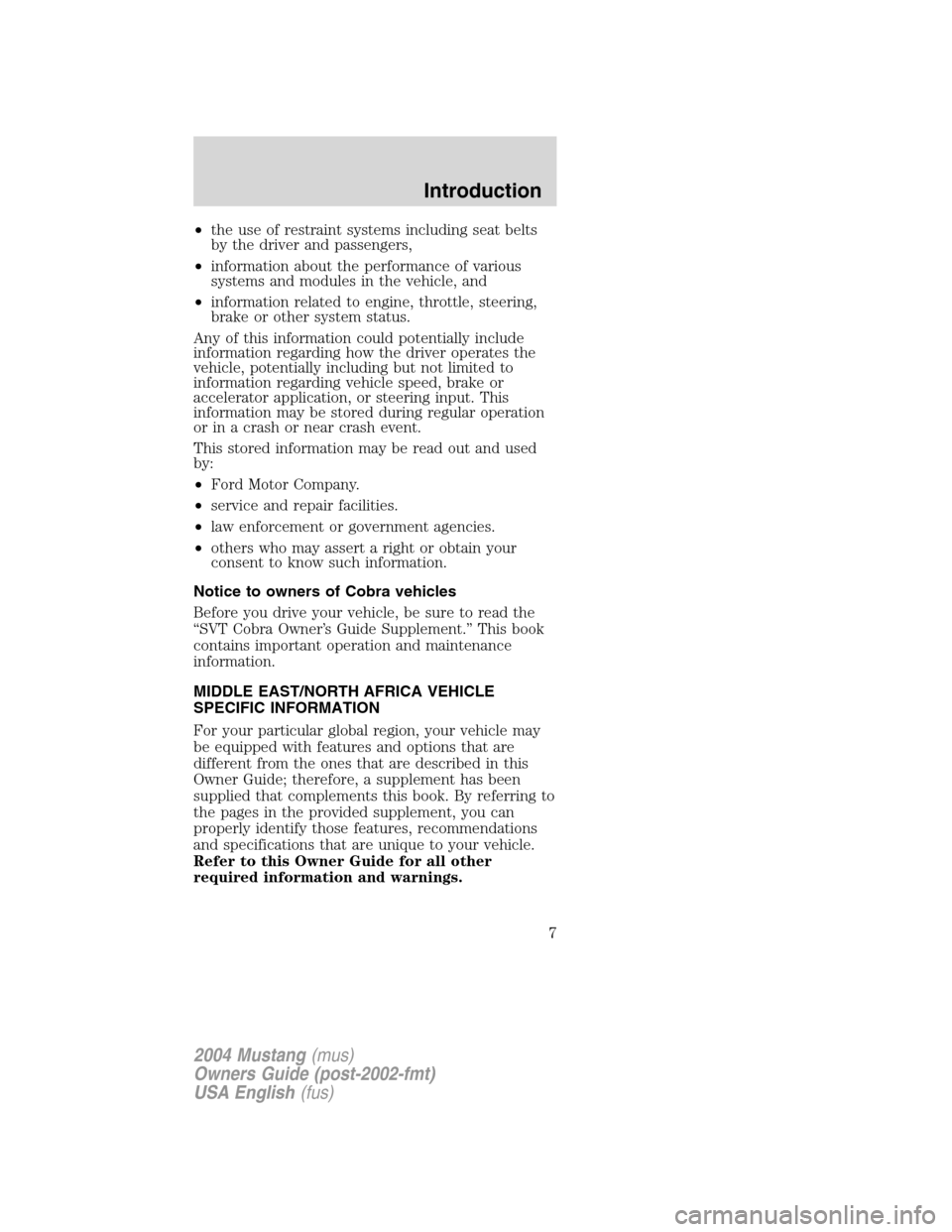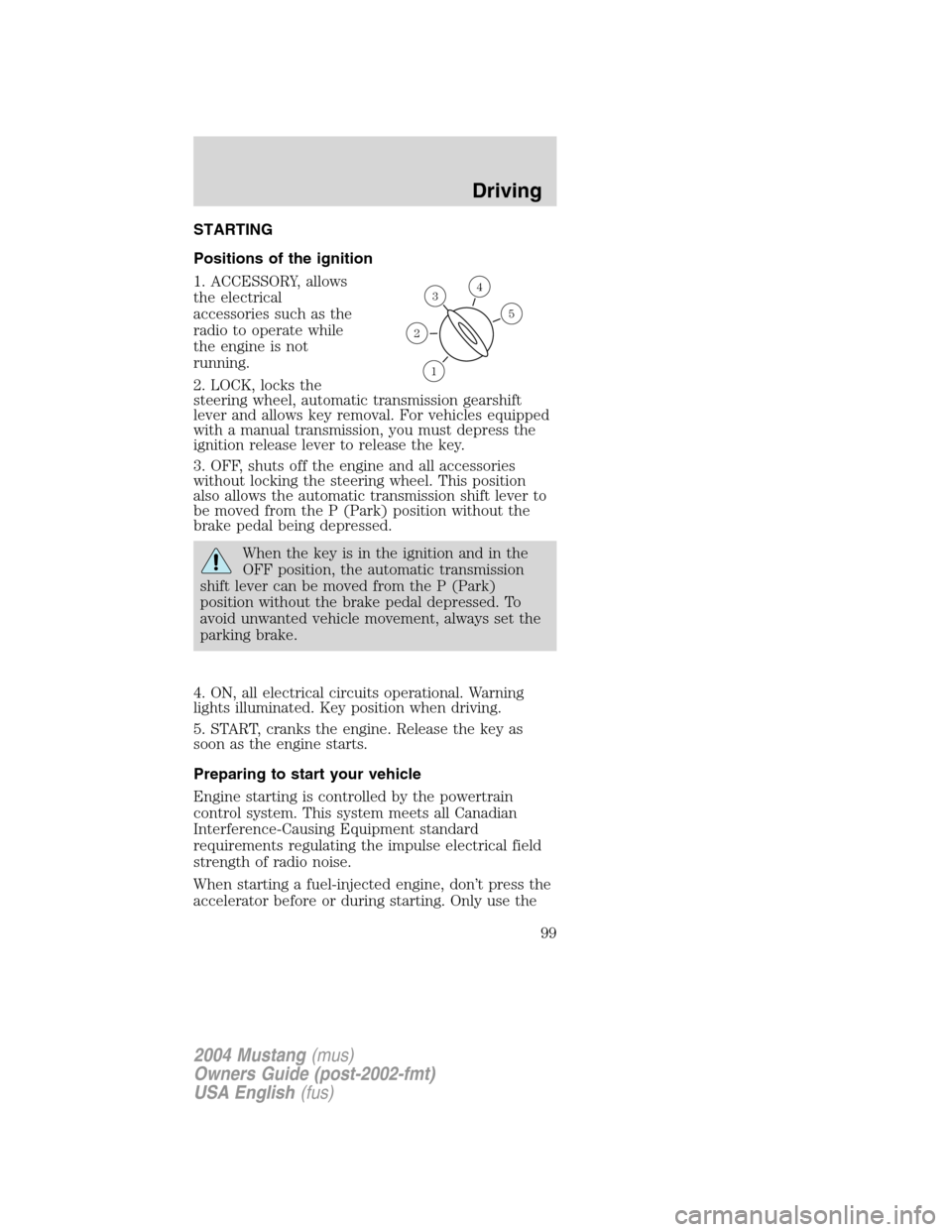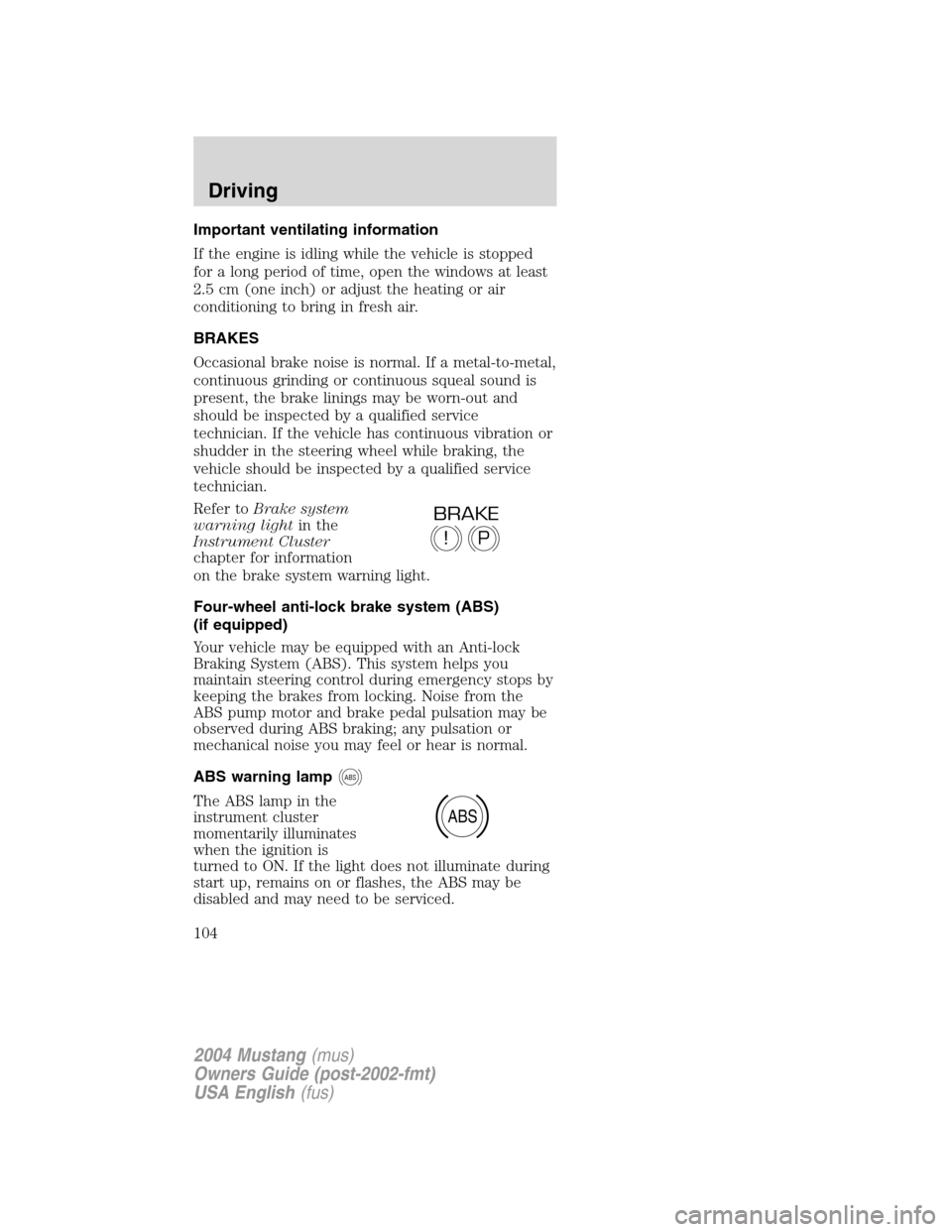Page 1 of 240
Introduction 4
Instrument Cluster 10
Warning and control lights 10
Gauges 14
Entertainment Systems 18
AM/FM stereo with CD 18
AM/FM stereo with in-dash six CD 25
Climate Controls 33
Manual heating and air conditioning 33
Rear window defroster 34
Lights 35
Headlamps 35
Turn signal control 38
Bulb replacement 38
Driver Controls 43
Windshield wiper/washer control 43
Steering wheel adjustment 44
Power windows 45
Mirrors 46
Speed control 46
Locks and Security 54
Keys 54
Locks 54
Anti-theft system 57
2004 Mustang(mus)
Owners Guide (post-2002-fmt)
USA English(fus)
Table of Contents
1
Page 7 of 240

•the use of restraint systems including seat belts
by the driver and passengers,
•information about the performance of various
systems and modules in the vehicle, and
•information related to engine, throttle, steering,
brake or other system status.
Any of this information could potentially include
information regarding how the driver operates the
vehicle, potentially including but not limited to
information regarding vehicle speed, brake or
accelerator application, or steering input. This
information may be stored during regular operation
or in a crash or near crash event.
This stored information may be read out and used
by:
•Ford Motor Company.
•service and repair facilities.
•law enforcement or government agencies.
•others who may assert a right or obtain your
consent to know such information.
Notice to owners of Cobra vehicles
Before you drive your vehicle, be sure to read the
“SVT Cobra Owner’s Guide Supplement.”This book
contains important operation and maintenance
information.
MIDDLE EAST/NORTH AFRICA VEHICLE
SPECIFIC INFORMATION
For your particular global region, your vehicle may
be equipped with features and options that are
different from the ones that are described in this
Owner Guide; therefore, a supplement has been
supplied that complements this book. By referring to
the pages in the provided supplement, you can
properly identify those features, recommendations
and specifications that are unique to your vehicle.
Refer to this Owner Guide for all other
required information and warnings.
2004 Mustang(mus)
Owners Guide (post-2002-fmt)
USA English(fus)
Introduction
7
Page 9 of 240
Vehicle Symbol Glossary
Child Safety Door
Lock/Unlock
Interior Luggage
Compartment
Release Symbol
Panic AlarmEngine Oil
Engine CoolantEngine Coolant
Temperature
Do Not Open When
HotBattery
Avoid Smoking,
Flames, or SparksBattery Acid
Explosive GasFan Warning
Power Steering
FluidMaintain Correct
Fluid LevelMAX
MIN
Emission SystemEngine Air Filter
Passenger
Compartment Air
FilterJack
Check fuel capLow tire warning
2004 Mustang(mus)
Owners Guide (post-2002-fmt)
USA English(fus)
Introduction
9
Page 44 of 240
TILT STEERING WHEEL (IF EQUIPPED)
To adjust the steering
wheel:
1. Pull and hold the
steering wheel release
control toward you.
2. Move the steering
wheel up or down until
you find the desired
location.
3. Release the steering wheel release control. This
will lock the steering wheel in position.
Never adjust the steering wheel when the
vehicle is moving.
OVERHEAD STORAGE NET (IF EQUIPPED)
Be sure to
secure objects
when placed in the
storage net in order
to help reduce the
risk that they
become projectiles in
the event of a
collision.
2004 Mustang(mus)
Owners Guide (post-2002-fmt)
USA English(fus)
Driver Controls
44
Page 47 of 240
Setting speed control
The controls for using
your speed control are
located on the steering
wheel for your
convenience.
1. Press the ON control
and release it.
2. Accelerate to the desired speed.
3. Press the SET
ACCEL control and
release it.
4. Take your foot off
the accelerator pedal.
Note:
•Vehicle speed may vary momentarily when driving
up and down a steep hill.
•If the vehicle speed increases above the set speed
on a downhill, you may want to apply the brakes
to reduce the speed.
•If the vehicle speed decreases more than 16 km/h
(10 mph) below your set speed on an uphill, your
speed control will disengage.
Resuming a set speed
Press the RESUME
control and release it.
This will automatically
return the vehicle to
the previously set
speed. The RESUME
control will not work if
the vehicle speed is not
faster than 48 km/h (30 mph).
OFF ON
RESUME
SET
ACCEL
COAST
RESUME
SET
ACCEL
COAST
2004 Mustang(mus)
Owners Guide (post-2002-fmt)
USA English(fus)
Driver Controls
47
Page 99 of 240

STARTING
Positions of the ignition
1. ACCESSORY, allows
the electrical
accessories such as the
radio to operate while
the engine is not
running.
2. LOCK, locks the
steering wheel, automatic transmission gearshift
lever and allows key removal. For vehicles equipped
with a manual transmission, you must depress the
ignition release lever to release the key.
3. OFF, shuts off the engine and all accessories
without locking the steering wheel. This position
also allows the automatic transmission shift lever to
be moved from the P (Park) position without the
brake pedal being depressed.
When the key is in the ignition and in the
OFF position, the automatic transmission
shift lever can be moved from the P (Park)
position without the brake pedal depressed. To
avoid unwanted vehicle movement, always set the
parking brake.
4. ON, all electrical circuits operational. Warning
lights illuminated. Key position when driving.
5. START, cranks the engine. Release the key as
soon as the engine starts.
Preparing to start your vehicle
Engine starting is controlled by the powertrain
control system. This system meets all Canadian
Interference-Causing Equipment standard
requirements regulating the impulse electrical field
strength of radio noise.
When starting a fuel-injected engine, don’t press the
accelerator before or during starting. Only use the
3
1
2
5
4
2004 Mustang(mus)
Owners Guide (post-2002-fmt)
USA English(fus)
Driving
99
Page 104 of 240

Important ventilating information
If the engine is idling while the vehicle is stopped
for a long period of time, open the windows at least
2.5 cm (one inch) or adjust the heating or air
conditioning to bring in fresh air.
BRAKES
Occasional brake noise is normal. If a metal-to-metal,
continuous grinding or continuous squeal sound is
present, the brake linings may be worn-out and
should be inspected by a qualified service
technician. If the vehicle has continuous vibration or
shudder in the steering wheel while braking, the
vehicle should be inspected by a qualified service
technician.
Refer toBrake system
warning lightin the
Instrument Cluster
chapter for information
on the brake system warning light.
Four-wheel anti-lock brake system (ABS)
(if equipped)
Your vehicle may be equipped with an Anti-lock
Braking System (ABS). This system helps you
maintain steering control during emergency stops by
keeping the brakes from locking. Noise from the
ABS pump motor and brake pedal pulsation may be
observed during ABS braking; any pulsation or
mechanical noise you may feel or hear is normal.
ABS warning lamp
ABS
The ABS lamp in the
instrument cluster
momentarily illuminates
when the ignition is
turned to ON. If the light does not illuminate during
start up, remains on or flashes, the ABS may be
disabled and may need to be serviced.
P!
BRAKE
ABS
2004 Mustang(mus)
Owners Guide (post-2002-fmt)
USA English(fus)
Driving
104
Page 105 of 240

Even when the ABS is
disabled, normal
braking is still effective.
(If your BRAKE
warning lamp illuminates with the parking brake
released, have your brake system serviced
immediately.)
Using ABS
When hard braking is required, apply continuous
force on the brake pedal; do not pump the brake
pedal since this will reduce the effectiveness of the
ABS and will increase your vehicle’s stopping
distance. The ABS will be activated immediately,
allowing you to retain full steering control during
hard braking and on slippery surfaces. However, the
ABS does not decrease stopping distance.
Hydraulic brake booster system (Hydroboost)
(if equipped)
The Hydroboost system receives fluid pressure from
the power steering pump to provide power assist
during braking.
For Hydroboost-equipped vehicles operating under
normal conditions, the noise of the fluid flowing
through the booster may be heard whenever the
brake is applied. This condition is normal; vehicle
service is not required.
If braking performance or pedal response becomes
very poor, even when the pedal is strongly
depressed, it may indicate the presence of air in the
hydraulic system or leakage of fluid. Stop the vehicle
safely as soon as possible and seek service
immediately.
P!
BRAKE
2004 Mustang(mus)
Owners Guide (post-2002-fmt)
USA English(fus)
Driving
105